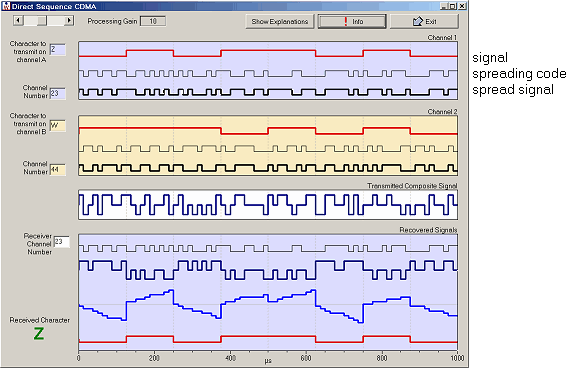| Learning by Simulations has been developed by Hans Lohninger to support both teachers and students in the process of knowledge transfer and acquisition . Click here for more information. |

Home  Computer Science Computer Science  Direct Sequence CDMA Direct Sequence CDMA |
|||||||||
Share this Page:







The "Direct Sequence" process (DS) is probably the most well known and the most applied Spread Spectrum technology. Here, the data signal is multiplied by a pseudo random code (PN code - pseudo noise code), which has similar characteristics as noise does. The code length of the PN code determines here the spreading of the spectrum (Processing Gain Gp).
The spreading of the spectrum takes place in the time domain simply via the multiplication of the wanted signal (top trace) with a spreading code (middle trace). The arising spread signal can be transformed by repeated multiplication with the spreading code back into the information signal. By spreading the spectrum, the total output of the signal remains constant, however the spectral power density is lowered accordingly, so that the information signal falls below the noise level (which is caused by other wanted signals, which are also spread) of the spread signal. In the receiver, the signal is multiplied again by the (synchronized) spreading code, so that the actual wanted signal results again. If a narrow-band interference signal is added during the transmission, then this will be spread during the decoding in the receiver and thus made "innocuous". The following illustration shows this situation:
The program "dscdma" lets the user select two different channels which can be used to transmit different characters. All the encoding and decoding steps are visualized in full detail.
|
|||||||||
Last Update: 2005-Dec-17



